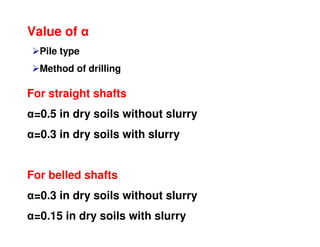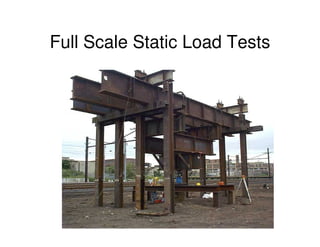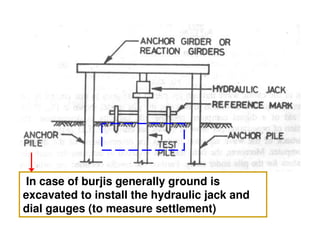Load carrying capacity of piles
- 1. Load Transfer Mechanism Fig. gives a single pile of uniform diameter d (circular or any other shape) and length L driven into a homogeneous mass of soil of known physical properties. A static vertical load is applied on the top. It is required to determine the ultimate bearing capacity Qu of the pile.
- 2. Load carrying capacity of piles A pile foundation should be safe against shear failure Settlement should be within the permissible limits Four different categories to measure the load carrying capacity of piles Static methods Dynamic formulas In-situ penetration tests Pile load tests
- 3. Static Formula Ultimate load capacity of individual pile or group of piles (Group pile) (Qu) Depending upon characteristics of the soil Qu=Qp+Qs Qu=Ultimate failure load Qp=Point resistance of the pile Qs= Shaft resistance developed by friction between the soil and pile Load (Q) Qp QsQs
- 4. Static Analysis Qf= Qb + Qs Where Qf = Net ultimate pile load or the load which can be supported by a pile top at failure. Qb = Net load carried by the pile base or total base resistance. Qs = The load carried by the pile shaft or total shaft resistance Or Qf = fb x Ab + fs x As
- 6. Qp=Point resistance of the pile Qp= qp x Ap qp=Ultimate bearing capacity of the soil Ap= Area of the pile tip (Generally circular) Load (Q) Qp
- 7. For square foundation γ γ γγ γ BNNDq BNqNq qfu qu 4.0 4.0 += += γγγ BNNDq qfu 3.0+= For circular foundation Shallow foundations in sand Meyerhof’s Method In case of Sand
- 8. Meyerhof’s Method It has been established that the effective vertical pressure (q) at the pile tip increases with depth only until a certain depth (Critical Depth Dc) q Dc Depth q=γxD
- 9. In Pile Foundation Critical depth depends upon the angle of internal friction and width or diameter of the pile (Charts available) Dc/B ɸ Critical depth can roughly be taken as 10 B for loose sands and 20 B for dense sands
- 11. For square foundation γ γ γγ γ BNNDq BNqNq qcp qp 4.0 4.0 += += γγγ BNNDq qcp 3.0+= For circular foundation Pile foundations in sand q=Effective vertical pressure at the pile tip γ=Unit weight of the soil in the zone of pile tip Dc=Critical depth Nq and Nγ= Bearing capacity factors for deep foundation (Charts available) B= Pile width or diameter
- 12. For square foundation γγγ BNNDq qcp 4.0+= γγγ BNNDq qcp 3.0+= For circular foundation Pile foundations in sand q=Effective vertical pressure at the pile tip γ=Unit weight of the soil in the zone of pile tip Dc=Critical depth Nq and Nγ= Bearing capacity factors for deep foundation (Charts available) B= Pile width or diameter
- 13. For square foundation qcp NDq γ= qcp NDq γ= For circular foundation Pile foundations in sand q=Effective vertical pressure at the pile tip γ=Unit weight of the soil in the zone of pile tip Dc=Critical depth Nq and Nγ= Bearing capacity factors for deep foundation (Charts available) B= Pile width or diameter
- 15. Meyerhof’s method for qp QP=ApxqxNq ≤ Apxql ql (kN/m2)=limiting stress=50xNqxtanɸ ≤11000 kPa (110 t/ft2) qNq≤ ql Be careful for critical parameters q=effective vertical pressure at pile tip = γxDc
- 16. Nq values Assumed that the soil above the pile tip is similar to the soil below the pile tip If pile penetrates the above hard or compact stratum only slightly and soil above the pile tip is loose stratum….then….. It would be more appropriate to use the value of Nq for a shallow foundation
- 17. Meyerhof’s method for qp The point bearing capacity (qp) of pile generally increases with the depth of embedment (Db) in the bearing stratum Load (Q) Qp G.L Loose stratum Bearing stratum Db
- 18. Meyerhof’s method for qp Load (Q) Qp G.L Loose stratum Bearing stratum Db Db reaches to a maximum value at an embedment ratio of (Db/B)cr Critical ratio (Db/B)cr depends upon soil friction angle Determine Nq
- 19. If Load (Q) Qp G.L Loose stratum Bearing stratum Db<10B kPaqD B qq qq lb ll lp 11000 10 )2( )1()2( )1( ≤≤ − += Db=Depth of penetration in dense sand
- 20. ql(1)=limiting unit point resistance of loose sand=50Nq1tanɸ1(kN/m2) ql(2)=limiting unit point resistance of dense sand=50Nq2tanɸ2(kN/m2) Db=Depth of penetration in dense sand
- 21. ( ) ( ) ( )depthscouringoranyifsoilweakinportiondeducting sandwithinembededactuallylengthdepthPileL esubmergencand pressureoverburdenforcorrected basepile ofvicinitytheinSPTofvalueNAverageN siltsplasticNonkPaN SandskPaN B L Nq p p p , )( point)pilethebelowDia4andaboveDia10About( 300 40040 = = ≤ ≤=
- 22. qp(gross)=cNc + qNq q =vertical stress=(γxDf) for ɸ=0, Nq=1 qp(gross)=cNc + q qp(net)=cNc Qp=cNcxAp c=Cohesion Nc=Bearing capacity factor for deep foundation Generally 9.0 for pile (but vary in some cases) For Clay
- 23. ( ) 4/ 0.9 . resistanceBase ≥ = = == BLwhere astakengenerally factorcapacitybearingpileN undrainedbasebelowcohesionc Ncf p cp cpb Analysis of pile capacity in clay
- 24. Where qp= fb = unit base resistance qs= fs = unit skin friction or unit shaft resistance Ab = Area of pile base (depends upon the shape) As = Surface area of pile shaft. Pile Capacity in Sand (Effective stress method) (((( )))) depthcriticalD D.pileoflengthEmbeddedEffectiveL pileforforfactorcapacityBearingN )pileofbase(pileoftipatpressureoverburdenEffective )casesallfor( ft/torkPaNLNf C Cp qp o qppqpob ==== ≤≤≤≤==== ==== ====′′′′ ≤≤≤≤′′′′====′′′′==== φ σ γσ 2 11011000
- 26. Qs=Shaft resistance developed by friction between the soil and pile Qs=fsxAs fs=Cumulative average unit friction between the sand and the pile surface As=Effective surface area of the pile in contact with the soil (Perimeter X Length) Load (Q) QsQs Floating
- 27. fs=Average unit friction between the sand and the pile surface Ω= tan ' vs Kf σ K= Coefficient of earth pressure σv ’= Effective vertical pressure at the depth under consideration =Coefficient of friction between soil and pile material (critical depth=15 Dia of Pile), after that frictional resistance remain constant
- 28. ≈ 20-15 Dia
- 29. 4.01.50.67 ɸTimber 2.01.00.75 ɸConcrete 1.00.520oSteel K (Dense sand) K (Loose sand) Pile material
- 30. (((( )))) Cssm s s smsss DbelowandatfofvalueMaximumf .pileandsandbetweenfrictionofAngle shaftpilealongpressureoverburdeneffectiveAverage shaftpileonpressureearthoftcoefficienAverageKWhere casesallfor ft/tonkPaftankf ==== ==== ====′′′′ ==== ====≤≤≤≤≤≤≤≤′′′′==== δ σ δσ 2 1100 The values of DC /B , Ks , tanδδδδ and Nqp (SAA !978) State Density Index ID DC /B Ks tanδδδδ Nqp Drive n Piles Bore d Piles Driven Piles Bored piles Loose 0.2-0.4 6 0.8 0.3 60 25 Mediu m 0.41- 0.75 8 1.0 0.5 100 60 Dense 0.76-0.9 15 1.5 0.8 180 100
- 31. Qs for driven piles in clay
- 32. Qs=Shaft resistance developed by friction between the soil and pile Qs=fsxAs fs=αc’ c’=Cumulative average cohesion along the pile shaft α=adhesion factor (Adhesion factor depends upon cohesion of soil) Charts available α METHOD
- 34. Qs=Shaft resistance developed by friction between the soil and pile Qs=fsxAs fs=ʎ(σv’+2c) [Vijayvergiya and Fochit (1972)] c=cohesion of soil ʎ=friction capacity factor (Friction capacity factor depends upon embedment length) Charts available ʎ METHOD
- 36. Care while calculating C and C’ Clay gets remolded while pile is driven Remolding factor must be taken in account Remolded strength must always be less than the undisturbed strength Strength improves with time Rate of gain of strength depends upon Consolidation characteristics Rate of dissipation of excess pore water pressure
- 37. . 5.00.1 .45.0 100 pilesdrivenofcasein claystiffforandclayssoftfor pilesboredforfactorAdhesion kPacffrictionSkin avs = === ≤== α α Analysis of pile capacity in clay
- 38. From CPT (Plastic soils like clay) (((( )))) m.Bfor m.Bfor.safetyoffactoruseloadAllowable N C.C.Ofor. C.C.Nfor N q f N N N q Nf k o o k avc os k cp k c cpb 503 5052 20 50 1 20 9 >>>> ≤≤≤≤ ==== ==== ======== ≅≅≅≅==== ====××××==== α αα
- 39. Method Based on CPT (for driven piles) (Non Plastic soils like sand) siltplasticNon q sand q f qf avc avc s cb 150 200 ==== ==== ==== Allowable load: apply Factor of safety 2.5-3.0
- 40. Methods based on SPT (Empirical relationship) Driven Piles (By Meyerhof, C.G.Manual) (((( )))) Csb CpCpsC s ba psb Cpp s ba Datcalculatedarefandf DLforDLBfBD fB fQ or Latcalculatedarefandf DLforBL fB fQ ≥≥≥≥ −−−−++++ ++++ ××××==== ≤≤≤≤ ++++ ××××==== ππ π π π 243 1 243 1 2 2
- 41. Bored Piles
- 42. For Bored Piles ( ) 4: 2 2 1 2 1 40 3 1 3 1 safetyoffactorApplyLoadAllowable kPaNpilesDrivenoff B L Npiledrivenofrdf avs p b == ==
- 43. The load carrying capacity of bored piles can be determined using the same procedure as that of driven piles The values of soil parameters are different between driven and bored piles
- 44. Bored piles in sand Ultimate load capacity of individual pile or group of piles (Group pile) (Qu) Depending upon characteristics of the soil Qu=Qp+Qs Qu=Ultimate failure load Qp=Point resistance of the pile Qs= Shaft resistance developed by friction between the soil and pile Load (Q) Qp QsQs
- 45. Bored piles in sand ( )∑= Ω+= n i ispqu AvKANqQ 1 '' )(tanσ Qp Qs q’ and σv ’= Effective vertical pressure, limited to a maximum value given by critical depth K= Lateral earth pressure coefficient for bored foundation tan =coefficient of friction between soil and pile material
- 46. K=1-sinɸ Approximate value K generally varies between 0.3 and 0.75 An average value of 0.5 is usually adopted K values tan values Can be taken equal to tanɸ for bored piles excavated in dry soil If slurry is used while excavation value of tan will reduced
- 47. In general, for a given value of ɸ, bored piles have a unit point resistance of 1/2 to 2/3 of that of corresponding driven piles Why??? In driven piles there is densification
- 48. Ultimate load capacity of individual pile or group of piles (Group pile) (Qu) Depending upon characteristics of the soil Qu=Qp+Qs Qu=Ultimate failure load Qp=Point resistance of the pile Qs= Shaft resistance developed by friction between the soil and pile Load (Q) Qp QsQs Static method for bored piles in clay
- 49. Bored piles in clay '' spcu AcAcNQ α+= Qp Qs As’=Area of shaft that is effective in developing skin friction
- 50. Value of α Pile type Method of drilling For straight shafts α=0.5 in dry soils without slurry α=0.3 in dry soils with slurry For belled shafts α=0.3 in dry soils without slurry α=0.15 in dry soils with slurry
- 51. Effective area of shaft for skin friction (As’) Depends upon embedded length of shaft in soil that is effective in developing skin friction The lower 1.5 m (or 2B) and top 1.5 m (or 2B) is neglected Why? Because of the disturbance Generally, for bored piles installed in stiff clay C=0.75 C (obtained from Triaxial test)
- 52. Negative Skin Friction When soil layer surrounding the portion of the pile shaft settles more than pile A downward drag occurs on the pile The drag is known as negative skin friction Extra downward load on pile
- 53. nsfuu QQQ −=' Negative Skin Friction Qu’= net ultimate load Qnsf= Drag down fce Qnsf is computed using the same method as we discussed for the positive frictional resistance
- 54. Pile Load Test Most Reliable Method
- 55. Full Scale Static Load Tests
- 56. Full Scale Static Load Tests
- 57. Full Scale Static Load Tests
- 58. Full Scale Static Load Tests
- 59. Full Scale Static Load Tests
- 60. Full Scale Static Load Tests
- 61. Full Scale Static Load Tests
- 62. Pile Load Test Setup Burjis are very commn in Pakistan
- 63. Pile Load Test Sand bag loading is very common practice in Pakistan
- 64. In case of burjis generally ground is excavated to install the hydraulic jack and dial gauges (to measure settlement)
- 65. Calibration of dial gauges and hydraulic jack (loading gauge) must be conducted before test
- 66. Pile Load Test Setup 3B or 2.5 m
- 67. When pile load test shall be conducted 3 days after installation in sandy soils One month after installation in silts and clays (soft clays) How shall be the application of load Equal increments of about 20% of the allowable load (Load at which pile will be tested) (Test load= Twice the safe load or the load at which the total settlement reaches the specified value
- 68. How to record settlement At least with three dial gauges When to increase/change the load Rate of movement of the pile top is not more than 0.1 mm/hour for sandy soils 0.02 mm/hour for clayey soils Two hours maximum
- 69. Time interval to observe settlement 0.5 min, 1 min, 2 min, 4 min, 8 min, 15 min, 30 min, 1 hour and 2 hours The last stage of loading will be continued for 24 hours or even more depending upon the settlement
- 70. How to remove the load With the same increments and 1 hour interval Final rebound is recorded for 24 hours after the entire load has been removed
- 71. Typical load-settlement (unload-rebound curve of a pile test Sn=St-Se
- 72. Safe load?? 2/3 of the final load at which total settlement is 12 mm 2/3 of the load corresponding to a net settlement of 6 mm 1/2 of load corresponding to a total settlement of (B/10) (7.5% incase of under- reamed pile) The least of below
- 73. The limiting criteria (sometimes specified) Under the total load (twice the safe load) The net settlement should not be more than 20 mm The gross settlement should not be more than 25 mm
- 74. To construct a pre-stressed bridge, a 30 cm diameter pile of length 12 m was subjected to a pile load test and the following results were obtained. Determine the allowable load 6.05.85.55.24.64.0Settlement during unloading (cm) 6.03.82.551.650.850Settlement during loading (cm) 25002000150010005000Load (kN)


































![Qs=Shaft resistance developed by friction
between the soil and pile
Qs=fsxAs
fs=ʎ(σv’+2c) [Vijayvergiya and Fochit (1972)]
c=cohesion of soil
ʎ=friction capacity factor (Friction capacity factor depends
upon embedment length)
Charts available
ʎ METHOD](https://image.slidesharecdn.com/11-loadcarrtingcapacityofpiles09ce-180225073622/85/Load-carrying-capacity-of-piles-34-320.jpg)








































